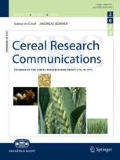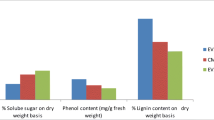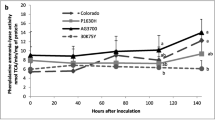Abstract
Banded leaf and sheath blight (BLSB) of maize is an emerging disease in the northwest region of India. The present study investigates the potential role of defense-related enzymes in imparting resistance against Rhizoctonia solani in seven inbreds, viz., LMDR-2, CM-143, CM-600, LM-11, LM-12, LM-13 and LM-14, and four maize hybrids, viz., PMH1, PMH2, PMH4 and JH3459. The enzyme activities were determined from the leaf sheaths collected at 0, 24, 48, 72, 96, 120 and 144 h post-inoculation. The results indicated a spike in the expression of phenylalanine ammonia-lyase (PAL), polyphenol oxidase (PPO), peroxidase (POX) and catalase (CAT) at 72 h post-inoculation following pathogen challenge in different maize inbreds/hybrids. The moderately resistant group (LMDR-2 and JH3459) showed significantly higher activities than the susceptible group (LM-11, LM-12, CM-600, PMH4 and PMH2). A strong positive correlation was observed between different enzymes at 72 and 96 h after inoculation. Lesion length showed negative correlation with the activities of enzymes studied. Our results indicated that PAL, PPO, POX and CAT played key roles in providing BLSB resistance in maize inbreds/hybrids.



Similar content being viewed by others
Availability of data and material
The data generated and/or analyzed during the present study are attached as supporting information and can also be obtained from the corresponding author on request.
Reference
Agrios GN (2005) Plant pathology, 5th edn. Elsevier Academic Press, San Diego USA
Ashry NA, Mohamed HI (2011) Impact of secondary metabolites and related enzymes in flax resistance and or susceptibility to powdery mildew. World J Agric Sci 7:78–85
Balmer D, Planchamp C, Mauch-Mani B (2013) On the move: induced resistance in monocots. J Exp Bot 64:1249–1261
Bastin M, Unluer O (1972) Effect of actinomycin-D on the formation of enzymes in Jerulaselam artichoke tuber discs. Planta 102:3357–3361
Bertus LS (1927) Year Book Dep Agric Ceylon, 44–46
Bintang AS, Wibowo A, Priyatmojo A, Subandiyah S (2017) Morphological and molecular characterization of Rhizoctonia solani isolates from two different rice varieties. J Perlindungan Tanaman Indonesia 21:72–79
Broz AK, Broeckling CD, De-la-Pena C, Lewis MR, Greene E, Callaway RM et al (2010) Plant neighbour identity influences plant biochemistry and physiology related to defence. BMC Plant Biol 10:115
Burrell MM, Rees TA (1974) Metabolism of phenylalanine and tyrosine in rice leaves infected by Pyricularia oryzae. Physiol Plant Pathol 4:497–508
Chance B, Maehly AC (1955) Assay of catalase and peroxidase. Meth Enzymol 2:764–775
Chen GP, Tan H, Zheng DB, Yang LT, Li YR (2009) QTL mapping of resistance to banded leaf and sheath blight in maize. Southwest China J Agric Sci 22:950–955
Dahima VI, Sharma SS, Khokhar MK, Hooda KS (2014) Post-infectional biochemical changes in maize leaves affected by banded leaf and sheath blight disease. Indian Phytopathol 67:370–373
Demissie AG (2017) Structure and function of disease resistance proteins in plants. American J Microbiol Immunol 2:1–6
Devi B, Guleria SK, Thakur BR (2015) Reactions of maize genotypes against banded leaf and sheath blight. Himachal J Agric Res 41:168–171
Dhkal M, Hunjan MS, Kaur H, Kaur R (2016) Biochemical basis of bacterial leaf streak resistance in maize. Indian Phytopathol 69:373–380
Dieng H, Satho T, Hassan AA, Aziz AT, Morales RE, Hamid SA, Abubakar S (2011) Peroxidase activity after viral infection and whitefly infestation in juvenile and mature leaves of Solanum lycopersicum. J Phytopathol 159:707–712
Gao J, Chen Z, Luo M, Peng H, Lin HJ, Qin C, Yuan GS, Shen YO, Ding HP, Zhao MJ, Pan GT, Zhang ZM (2014) Genome expression profile analysis of the maize sheath in response to inoculation to Rhizoctonia solani. Mol Bio Rep 41:2471–2483
Garg A, Prasanna BM, Sharma RC, Rathore RS, Saxena SC, Chauhan SVS (2007) Identification of resistance sources to banded leaf and sheath blight (Rhizoctonia solani f. sp. sasakii) in maize. Indian Phytopathol 60:162–166
Garg A, Prasanna BM, Sharma RC (2009) Genetic analysis and mapping of QTLs for resistance to banded leaf and sheath blight (Rhizoctonia solani f.sp. sasakii) in maize. In:Proc on 10th Asian regional maize workshop. Makassar, Indonesia
Hemm MR, Rider SD, Ogas J, Murry DJ, Chappel C (2004) Light induces phenyl propanoid metabolism in Arabidospsis roots. Plant J 8:765–778
Hooda KS, Bagaria PK, Khokhar M, Kaur H, Rakshit S (2018) Mass screening techniques for resistance to maize diseases. ICAR-Indian Institute of Maize Research PAU, Campus, Ludhiana, p 93
IBM Corp (2019) IBM SPSS Statistics for Windows, Version 26.0. Armonk, NY: IBM Corp
Jang IC, Park SY, Kim KY, Kwon SY, Kim JG, Kwak SS (2004) Differential expression of 10 sweet potato peroxidase genes in response to bacterial pathogen, Pectobacterium chrysanthemi. Plant Physiol Biochem 42:451–455
Jayaraj J, Ranganathan B, Ramalingam R, Muthukrishnan S, Rethinasamy V (2010) Oxalic acid-induced resistance to Rhizoctonia solani in rice is associated with induction of phenolics, peroxidase and pathogenesis-related proteins. J Plant Interact 5:147–157
Jockusch H (1966) The role of host genes, temperature and polyphenol oxidase in the necrotization of TMV infected tobacco tissue. J Phytopathol 55:185–192
Joseph LM, Koon TT, Man WS (1998) Antifungal effects of hydrogen peroxide and peroxidase on spore germination and mycelial growth of Pseudocercospora species. Canadian J Bot 76:2119–2124
Kaur H, Kumar S, Hooda KS, Gogoi R, Bagaria P, Singh RP, Mehra R, Kumar A (2020) Leaf stripping: an alternative strategy to manage banded leaf and sheath blight of maize. Indian Phytopathol 73:203–211
Kim DS, Hwang BK (2014) An important role of the pepper phenylalanine ammonia-lyase gene (PAL1) in salicylic acid-dependent signalling of the defence response to microbial pathogens. J Exp Bot 65:2295–2306
Kumar S, Kaur H (2020) Prevalence of banded leaf and sheath blight of maize in punjab and its management with fungicides. Agric Res J 57:738–744
Kumar A, Hunjan MS, Kaur H (2017) Biochemical responses associated with resistance to bacterial stalk rot caused by Dickeya zeae in maize. J Phytopathol 165:822–832
Lamb C, Dixon RA (1997) The oxidative burst in plant disease resistance. Annual Review of Physiol Plant Mol Biol 48:251–275
Li L, Stiffen JC (2002) Over expression of polyphenol oxidase in transgenic tomato plants results in enhanced bacterial disease resistance. Planta 215:239–247
Li N, Lin B, Wang H, Li X, Yang F, Ding X, Yan J, Chu Z (2019) Natural variation in ZmFBL41 confers banded leaf and sheath blight resistance in maize. Nat Genet 51:1540–1548
Lin H, Leng P, Pan G, Zhang Z (2013) Association analysis of candidate quantitative trait loci for resistance to banded leaf and sheath blight in maize. Int J Biosci Biochem Bioinform 3:528–534
Lojkowska E, Hołubowska M (1992) The role of polyphenol oxidase and peroxidase in potato tuber resistance to soft rot caused by Erwinia carotovora. J Phytopathol 136:319–328
Lore JS, Hunjan MS, Thind TS (2012) Standardization of inoculum amount for sheath blight development in rice under field conditions. Pl Dis Res 27:99–101
Madhavi M, Narayan PR, Ranga R, Sudarshan MR (2012) Evaluation of maize genotypes against banded leaf and sheath blight disease incited by Rhizoctonia solani f. sp. sasakii (Kuhn) Exner. J Res ANGRAU 40:20–23
Madhusudhan KN, Srikanta BM, Shylaja MD, Prakash HS, Shetty HS (2009) Changes in antioxidant enzymes, hydrogen peroxide, salicylic acid and oxidative stress in compatible and incompatible host tobamovirus interaction. J Plant Interact 4:157–166
Mahuku G (2010) Maize pathology in Asia: opportunities and challenges for breeding disease-resistant maize. In: Proceedings of the Asian regional maize workshop, 10, Makassar (Indonasia). pp 361–366
Maksimov I, Troshina N, Surina O, Cerepanova E (2014) Salicylic acid increases the defense reaction against bunt and smut pathogens in wheat calli. J Plant Interact 9:306–314
Meena BR, Yerasu SR, Gupta N, Singh J (2021) Resistance assessment and biochemical responses of maize genotypes against Rhizoctonia solani f. sp. sasakii Exner causing banded leaf and sheath blight disease. Australas Plant Pathol 50:41–49
Mehra R, Kamboj MC, Mehla JC, Lal M, Chand M (2012) Status of maize diseases and their management in Haryana. In: Proceeding on National Seminar on Sustainable Agriculture and Food Security: Challenges in Changing Climate p 217
Melo GA, Shimizu MM, Mazzafera P (2006) Polyphenoloxidase activity in coffee leaves and its role in resistance against the coffee leaf miner and coffee leaf rust. Phytochemistry 67:277–285
Mohamed H, EL-Hady AA, Mansour M, El-Rheem A, El-Samawaty A (2012) Association of oxidative stress components with resistance to flax powdery mildew. Tropical Plant Pathol 37:386–392
Mondal A, Dutta S, Nandi S, Das S, Chaudhuri S (2012) Changes in defence related enzymes in rice responding to challenges by Rhizoctonia solani. Arch Phytopathol Plant Prot 45:1840–1851
Munkvold GP, White DG (2016) Compedium of corn diseases, 4th edn. American Phytopathological society, USA pp 1–6
Mydalarz LD, Harvell CD (2006) Peroxidase activity and inducibility in the sea fan coral exposed to a fungal pathogen. Comp Biochem Physiol 146:54–62
Ngadze E, Icishahayo D, Coutinho TA, Van der JE (2012) Role of polyphenol oxidase, peroxidase, phenylalanine ammonia lyase, chlorogenic acid, and total soluble phenols in resistance of potatoes to soft rot. Plant Dis 96:186–192
Pal TK, Bhattacharaya S, Chakraborty K (2011) Induction of systemic resistance in rice by leaf extract of Cymbopogan citrus and Ocimum sanctum against sheath blight disease. Arch Appl Sci Res 3:392–400
Parihar PS, Prakash O, Punetha H (2012) Investigation on defensive enzymes activity of Brassica juncea genotypes during pathogenesis of Alternaria blight. Nature Sci 10:63–68
Pascual CB, Raymundo AD (1989) Evaluation of resistance and yield loss in sorghum due to Rhizoctonia sheath blight. Philippine J Crop Sci 14:133–135
Paul PK, Sharma PD (2002) Azadirachta indica leaf extract induces resistance in barley against leaf stripe disease. Physiol Mol Plant Pathol 61:3–13
Payak MM, Renfro BL (1966) Diseases of maize new to India. Indian Phytopathol Soc Bull 3:14–18
POP (2016) Package of practices for Kharif crops. Punjab Agricultural University, Ludhiana, pp 20–25
Prasanna BM, Pixley K, Marilyn L, Warburton Chuan XX (2010) Molecular marker-assisted breeding options for maize improvement. Asia Mol Breeding 26:339–356
Sabitha D (2009) Systemic induction of pathogenesis related proteins (PRs) in Alternaria solani elicitor sensitized tomato cells as resistance response. Sci Res Essays 4:685–689
Santigo R, De Armas R, Legaz M, Vicente C (2009) Changes in phenolic acids content, phenylalanine ammonia lyase and peroxidase activities in sugarcane leaves induced by elicitors isolated from Xanthomonas albilineans. Australas Plant Pathol 38:357–365
Shannon ML, Kay E, Lew JY (1996) Peroxidase isozyme from horseradish root. Biochem 3:2166–2172
Sharma RC, Vasal SK, Gonzalez F, Batsa BK, Singh NN (2002) Redressal of banded leaf and sheath blight of maize through breeding chemical and biological agents. In: Srinivas G, Zaidi PH, Prasanna BM, Gonzalez F and Lesnik K (eds) Proc 8th asian regional maize workshop: new technologies for the new millenium. pp 391–397
Siddique Z, Akhtar KP, Hameed A, Sarwar N, Haq IU, Khan SA (2014) Biochemical alteration in leaves of resistant and susceptible cotton genotypes infected systemically by cotton leaf curl Burewala virus. J Plant Interact 9:702–711
Stewart RJ, Sawyer BJB, Bucheli CS, Robinson SP (2001) Polyphenol oxidase is induced by chilling and wounding in pineapple. Funct Plant Biol 28:181–191
Stout MJ, Fidantsef AL, Duffey SS, Bostock RM (1999) Signal interactions in pathogen and insect attack: Systemic plant mediated interactions between pathogens and herbivores of the tomato, Lycopersicon esculentum. Physiol Mol Plant Pathol 54:115–130
Subedi S (2015) A review on important maize diseases and their management in Nepal. J Maize Res Dev 1:28–52
Tahsili J, Sharifi M, Safaie N, Esmaeilzadeh-Bahabadi S, Behmanesh M (2014) Induction of lignans and phenolic compounds in cell culture of Linum album by culture filtrate of Fusarium graminearum. J Plant Interact 9:412–417
Umesha S (2006) Phenylalanine ammonia lyase activity in tomato seedlings and its relation to bacterial canker disease resistance. Phytoparasitica 34:68–71
Usenik V, Mikulic-Petkovsek M, Solar A, Stampar F (2004) Flavonols of leaves in relation to apple scab resistance. J Plant Dis Protect 111:137–144
Vanitha SC, Niranjana SR, Umesha S (2009) Role of phenylalanine ammonia-lyase and polyphenol oxidase in host resistance to bacterial wilt of tomato. J Phytopathol 157:552–557
Viljevac M, Dugalic K, Stolfa I, Dermic E, Cvjetkovic B (2009) Biochemical basis of apple leaf resistance to Erwinia amylovora Infection. Food Tech Biotechnol 47:281–287
Wheeler BEJ (1969) An introduction to plant diseases. John Wiley and Sons Limited, London
Yang JP, Tang HT, Yang JX, Li X, Chen DQ, Zhang B, Shi YG, Huang YX (2005) Identification and inheritance of resistance of maize germplasm to sheath blight (Rhizoctonia solani). Acta Phytopathol Sinica 35:174–178
Yobo KS, Laing MD, Hunter CH, Morris MJ (2004) Biological control of Rhizoctonia solani by two Trichoderma species isolated from South African composted soil. South African J Plant Soil 88:265–268
Yoshida K, Kaothien P, Matsui T, Kawaoka A, Shinmyo A (2003) Molecular biology and application of plant peroxidase genes. J Appl Microbiol 60:665–670
Zhao M, Zhang Z, Zhang S, Li W, Jeffers DP, Rong T, Pan G (2006) Quantitative trait loci for resistance to banded leaf and sheath blight in maize. Crop Sci 46:1039–1045
Funding
The research was fully supported by Indian Council of Agricultural Research, New Delhi—Extramural grant ‘Characterization, population dynamics and management of Rhizoctonia in different cropping systems’ to HK and MSH.
Author information
Authors and Affiliations
Contributions
All authors contributed equally to this study. Material preparation, data collection and statistical analysis were performed by Sanjay Kumar. All authors prepared the manuscript.
Corresponding authors
Ethics declarations
Conflict of interest
The authors declare no conflict of interest.
Additional information
Communicated by M. R. Simon.
Supplementary Information
Below is the link to the electronic supplementary material.
Rights and permissions
Springer Nature or its licensor holds exclusive rights to this article under a publishing agreement with the author(s) or other rightsholder(s); author self-archiving of the accepted manuscript version of this article is solely governed by the terms of such publishing agreement and applicable law.
About this article
Cite this article
Kumar, S., Kaur, H., Hunjan, M.S. et al. Biochemical changes induced in the maize leaf sheath upon inoculation with Rhizoctonia solani incitant of banded leaf and sheath blight. CEREAL RESEARCH COMMUNICATIONS 51, 413–423 (2023). https://doi.org/10.1007/s42976-022-00310-0
Received:
Accepted:
Published:
Issue Date:
DOI: https://doi.org/10.1007/s42976-022-00310-0




